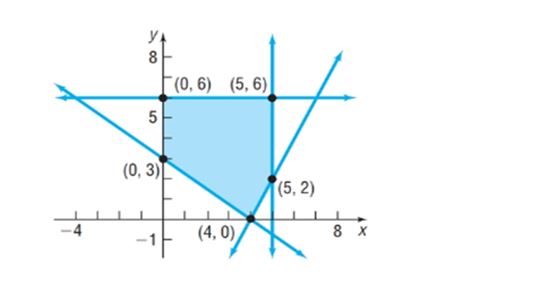
In problems 3-8, find the maximum and minimum value of the given objective function of a linear programming problem. The figure illustrates the graph of the feasible points.

To find: The maximum and minimum value of given objective function of a linear programming problem.
Answer to Problem 6AYU
Solution:
Maximum value is 56 and Minimum value is 3.
Explanation of Solution
Given:
From the graph, the corner points are .
Calculation:
The below table lists the corner points and the corresponding values of objective function.
| Corner points are | Value of objective function |
| 6 | |
| 56 | |
| 3 | |
| 52 | |
| 40 |
From the table, the maximum value is 56 and the minimum value is 3.
Chapter 11 Solutions
Precalculus Enhanced with Graphing Utilities
Additional Math Textbook Solutions
Calculus for Business, Economics, Life Sciences, and Social Sciences (14th Edition)
Pre-Algebra Student Edition
Elementary Statistics
Precalculus
Intro Stats, Books a la Carte Edition (5th Edition)
Basic Business Statistics, Student Value Edition
- Use the definite integral to find the area between the x-axis and f(x) over the indicated interval. Check first to see if the graph crosses the x-axis in the given interval. f(x)=4x-12; [2,6] The area between the x-axis and f(x) is (Type an integer or a simplified fraction.)arrow_forwardEvaluate the definite integral. 70 √5√2-6 3 dz 70 S 5√2-6 dz= 7 江 (Type an integer or decimal rounded to two decimal places as needed.)arrow_forwardFind the area between the following curves. 2 y=x³-x²+x+4; y=5x² -7x+4 The area between the curves is (Simplify your answer.) ...arrow_forward
- Find the area of the shaded region. 3- -1 -3- Q The total area of the shaded regions is (Simplify your answer.) y=9-x² Q 1 3 5 Xarrow_forwardFind the area of the region bounded by the graphs of the given equations. y=17x, y=x² ... The area is (Type an integer or a simplified fraction.)arrow_forwardFind the area between the curves. y=x-26, y=9-2x ... The area between the curves is (Type an integer or decimal rounded to the nearest tenth as needed.)arrow_forward
- You are constructing a box out of cardboard with the dimensions 5 m by 6 m. You then cut equal-size squares from each corner so you may fold the edges. Let x be the side length of each square. Find that maximizes the volume of the box. Answer exactly. 8 x x H x ४ x ४ ४ marrow_forward× Question 2 ▾ Score on last try: 0 of 1 pts. See Details for more. > Next question You can retry this question below Find two positive numbers x and y such that x + y = 14 and they minimize x² + y². x = Уarrow_forwardSup the is a -12 -10 -8 -6 -4 -2 16 Af(x) 8 -8- -16arrow_forward
- The function f is given by f(x) = cos(x + 1). The solutions to which 6 of the following equations on the interval 0≤ x ≤ 2 are the solutions to f(x) = 1½ on the interval 0 < x < 2π? 2 A √√3 cos x - sin x = 1 B √√3 cos x + sin x = 1 C √3 sin x COS x = 1 D √√3 sin x + cos x = 1arrow_forwardSuppose that the graph below is the graph of f'(x), the derivative of f(x). Find the locations of all relative extrema, and tell whether each extremum is a relative maximum or minimum. Af'(x) Select the correct choice below and fill in the answer box(es) within your choice. (Simplify your answer. Use a comma to separate answers as needed.) -10 86-4-2 -9- B 10 X G A. The function f(x) has a relative maximum at x= relative minimum at x = and a B. The function f(x) has a relative maximum at x= no relative minimum. and has C. There is not enough information given. D. The function f(x) has a relative minimum at x= no relative maximum. and has E. The function f(x) has no relative extrema.arrow_forwardK Find the x-values of all points where the function has any relative extrema. Find the value(s) of any relative extrema. f(x) = 12x+13x 12/13 Select the correct choice below and, if necessary, fill in any answer boxes within your choice. OA. There are no relative maxima. The function has a relative minimum of (Use a comma to separate answers as needed.) OB. There are no relative minima. The function has a relative maximum of (Use a comma to separate answers as needed.) OC. The function has a relative maximum of at x= (Use a comma to separate answers as needed.) OD. There are no relative extrema. at x= at x= and a relative minimum of at x=arrow_forward
 Calculus: Early TranscendentalsCalculusISBN:9781285741550Author:James StewartPublisher:Cengage Learning
Calculus: Early TranscendentalsCalculusISBN:9781285741550Author:James StewartPublisher:Cengage Learning Thomas' Calculus (14th Edition)CalculusISBN:9780134438986Author:Joel R. Hass, Christopher E. Heil, Maurice D. WeirPublisher:PEARSON
Thomas' Calculus (14th Edition)CalculusISBN:9780134438986Author:Joel R. Hass, Christopher E. Heil, Maurice D. WeirPublisher:PEARSON Calculus: Early Transcendentals (3rd Edition)CalculusISBN:9780134763644Author:William L. Briggs, Lyle Cochran, Bernard Gillett, Eric SchulzPublisher:PEARSON
Calculus: Early Transcendentals (3rd Edition)CalculusISBN:9780134763644Author:William L. Briggs, Lyle Cochran, Bernard Gillett, Eric SchulzPublisher:PEARSON Calculus: Early TranscendentalsCalculusISBN:9781319050740Author:Jon Rogawski, Colin Adams, Robert FranzosaPublisher:W. H. Freeman
Calculus: Early TranscendentalsCalculusISBN:9781319050740Author:Jon Rogawski, Colin Adams, Robert FranzosaPublisher:W. H. Freeman
 Calculus: Early Transcendental FunctionsCalculusISBN:9781337552516Author:Ron Larson, Bruce H. EdwardsPublisher:Cengage Learning
Calculus: Early Transcendental FunctionsCalculusISBN:9781337552516Author:Ron Larson, Bruce H. EdwardsPublisher:Cengage Learning





